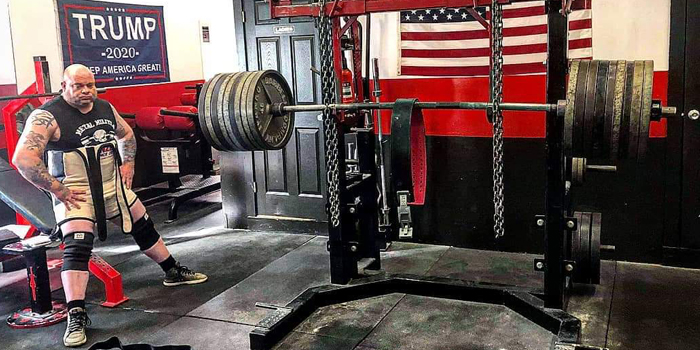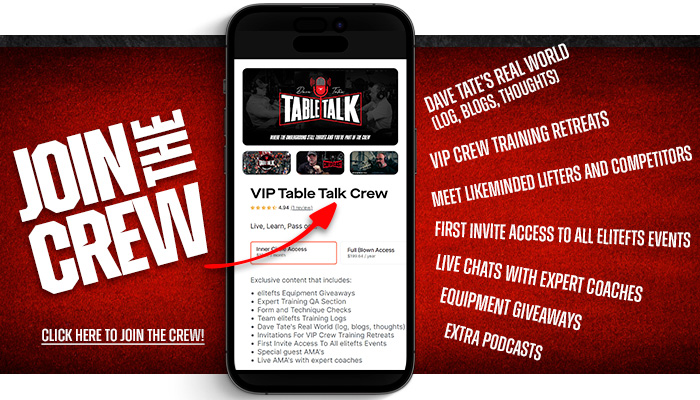
While training for competition, I wrecked my nervous system, and failed catastrophically. I was devastated. However, I corrected it in five weeks, just in time to squat 1000 pounds.
I am not going to state anything that should be taken for a fact, whether a person’s nervous system can get run down or fail (or not). People will argue that it is not possible to “tax” your nervous system until they are blue in the face. I am simply going to explain what happened to me, how it drastically affected my squat, and what I did as an experiment to correct it.
The First Four Weeks
I was training for a meet in Pennsylvania, and about eight weeks out from meet day, my coach programmed a three-week DE wave box squat with a fair amount of band tension. Up until this point, I had mostly only used chains for accommodating resistance. Little did I know how much heavy bands were about to affect me.
Week one went fantastic, and I smashed all the sets. So did week two. Week three was kind of a deload, still with bands and less weight. All was good until then and I was moving lightning fast off the box, perhaps the fastest I have ever been.
Week four was supposed to be full equipment paused squat into a two-inch high chain. For me, this involved special three-ply, fully grid stitched, “Al Mehan special cut” predator briefs, three-meter knee wraps, and a canvas leviathan.
At that time, we were gunning for that coveted 1,000-pound squat, and I had already done multiple low to mid-900s in competition. As a note, it took me three years to reach this point from the first time I squatted 900 pounds.
The Failure and Wrecked Nervous System
My squats on that training day consisted of ten percent jump increments. Everything went great working up through it, briefs up to 600 pounds, then suit on and knee wraps. The bar was loaded to 700 pounds, then 800 pounds. All was fine until the next attempt. At my 900-pound attempt, I got under the bar, set up, and took my air, but I could not unrack. I tried again and reset.
I still could not unrack! What happened?!
I could squat 900 pounds any day of the week, and suddenly now I can not even get it out of the rack.
I was devastated! Five weeks out and I can not even unrack my opener!
Do I back out? I want to.
After a lot of deliberation, I decided at this point to take my training into my own hands. Against my coach's best judgment, I the meet anyway and try an experiment. In the back of my mind, I thought I had gotten overtrained, but did not really know. This had happened before when I bombed a meet in Tennessee, so I did what I would do to correct that. For the next five weeks, I only took my wife's dynamic effort box squat weights, which were about 30-35 percent for me and only chain for accommodating resistance, plus my regular assistance exercises.
RECENT: Is Shirted Board Work Killing Your Bench Press?
Time for Competition
We drove to Pennsylvania, unsure of what the outcome would be, but sure in my mind, I needed to see this experiment through.
Squat warm-ups were not fantastic and we decided to lower the opener to 905 pounds. My first attempt went up, but not as easily as it should. We went mid-900s on the second, and it looked much better. It was then time to go for broke. We put in an attempt of 1005 pounds, and I got suited up and wrapped.
The bar is loaded. This is it!
When I got on the platform, they noticed, as I was setting up, the bar was only loaded to 1000 pounds. My coach said to take it rather than wait. I set up, I unracked, went down and up...BOOM! White lights!!
This was the highlight of my powerlifting career - to squat 1000 pounds, like so many of the lifters I looked up to at Westside Barbell had done before me. After twenty-plus years competing, I had done it.I was one of only six multiple lifters in my country to have ever moved one ton in the squat during competition.
The Importance of Five Weeks
The experiment had been a success, and a lot was learned. It also happened to fall in line with something a Bulgarian coach of my wife's had taught her—training should start to back down around five weeks out. Delayed Transformation is another thing that comes to mind from Louie Simmons. I have no doubt the heavy band dynamic effort work contributed to me squatting 1000 pounds, but I needed a substantial amount of time to rest afterward, to reap the benefits, five weeks.
They say hindsight is 20/20. If I had known the things I know now, I could have done much better. But I am still very proud of what I have accomplished and the long learning curve I traveled to reach it. Now I can pass knowledge on to other lifters, who are willing to listen, to maybe save them some time and heartbreak, or even injury (like a wrecked nervous system) in their powerlifting career.
Lessons Learned and Staying Grateful
As far as coaches go, I am sincerely grateful. I learned so much from the coaches I have had in the past: Ross Saldan, Brian Carroll, Dave Hoff, Bill Crawford, and Phil Harrington.
My advice? Learn and apply, and pay extreme attention to what you are being taught and how your body reacts to it. Like my friend Donnie Thompson says, "coach yourself.” You will eventually know your body and how it reacts better than anyone else.. I had to sacrifice loyalty and friendship to increase my numbers. It was an extremely hard decision, but after all, powerlifting is just you, yourself, against the weight and how far you are willing to go for the glory. I went all the way, with the opportunities I was offered and the genetics I have, over twenty-five-plus years on the platform.
"Three weeks out from a meet, you can’t get any stronger, but you can get weaker.” —Louie Simmons
Nathan Robertson is the previous owner of Amherst Powerlifting Club in Nova Scotia, Canada, and the current owner of Berserker Barbell in Saskatchewan, Canada. He competed for 25+ years in powerlifting, is an IPA Canada Chairman, and is an IPA and WPC International Judge. Nathan is one of only six 1000-pound squatters in Canada and a Top-10 overall Bencher in Canada. He is also a multiple IPA World Record Holder.











